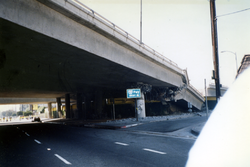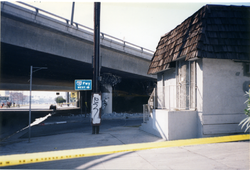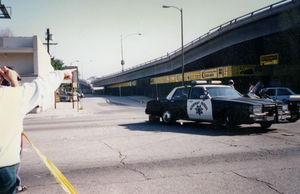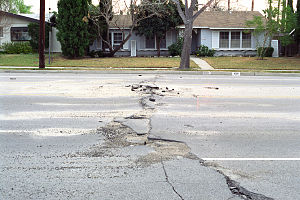- 1994 Northridge earthquake
-
Northridge earthquake of 1994 
Building collapsed as a result of the earthquakeDate January 17, 1994 Origin time 04:31 PST (12:30 UTC) Magnitude 6.7 Mw Depth 19.0 km (11.8 mi) Epicenter 34°12′25″N 118°32′06″W / 34.207°N 118.535°WCoordinates: 34°12′25″N 118°32′06″W / 34.207°N 118.535°W Countries or regions  United States
United States
(Southern California)Max. intensity IX - Violent Peak acceleration 1.7g Casualties 57 killed
more than 8,700 injuredThe Northridge earthquake was a massive earthquake that occurred on January 17, 1994, at 04:31 Pacific Standard Time in Reseda, a neighborhood in the city of Los Angeles, California, lasting for about 10–20 seconds.[1] The earthquake had a "strong" moment magnitude of 6.7, but the ground acceleration was one of the highest ever instrumentally recorded in an urban area in North America,[2] measuring 1.7 g (16.7 m/s2)[3] with strong ground motion felt as far away as Las Vegas, Nevada, over 270 miles (435 km) from the epicenter. The death toll came to a total of 57 people, and there were over 8,700 injured. In addition, the earthquake caused an estimated $20 billion in damage, making it one of the costliest natural disasters in U.S. history.[4]
Epicenter
The earthquake struck in the San Fernando Valley about 20 miles (31 km) northwest of downtown Los Angeles near the community of Northridge. The actual epicenter of the quake was in Reseda, near the intersection of Reseda Boulevard and Strathern Street. However, it took several days to pinpoint the epicenter with accuracy, and in the meantime the media had already dubbed it "The Northridge Earthquake." The name stuck, in part due to the extensive damage and loss of life in Northridge. The National Geophysical Data Center places the hypocenter's geographical coordinates at 34°12′47″N 118°32′13″W / 34.21306°N 118.53694°W and a depth of 17 km (10.56 mi). Despite the area's proximity to the San Andreas Fault, the Northridge quake did not occur along this fault, but rather on the previously undiscovered Northridge blind thrust fault (also known as the Pico thrust fault).[5]
Damage and fatalities
 I-10 skyway collapsed during the Northridge Earthquake.
I-10 skyway collapsed during the Northridge Earthquake.
 I-10 skyway after earthquake. Note that the collapsed section is near where the supporter beam is.
I-10 skyway after earthquake. Note that the collapsed section is near where the supporter beam is.
Damage occurred up to 85 miles (125 km) away, with the most damage in the west San Fernando Valley, and the cities of Santa Monica, Simi Valley and Santa Clarita. The number of fatalities is not certain, with sources estimating it at 60[6] or "over 60",[7] to 72,[8] where most estimates fall around 60.[9] The "official" death toll was placed at 57.[8] 33 people died immediately or within a few days from injuries sustained in the earthquake,[10] and many died from indirect causes, such as stress-induced cardiac events.[11][12] Some counts factor in related events such as a man's suicide possibly inspired by the loss of his business in the disaster.[8]
More than 8,700 were injured including 1,600 that required hospitalization.[13] The Northridge Meadows apartment complex was one of the well-known affected areas in which sixteen people were killed as a result of the building's collapse. The Northridge Fashion Center and California State University, Northridge also sustained very heavy damage—most notably, the collapse of parking structures. The earthquake also gained worldwide attention because of damage to the vast freeway network, which serves millions of commuters every day. The most notable of this damage was to the Santa Monica Freeway, Interstate 10, known as the busiest freeway in the United States, congesting nearby surface roads for three months while the freeway was repaired. Further north, Interstate 5 (the Golden State Freeway) and State Route 14 (the Antelope Valley Freeway) collapsed and had to be rebuilt. The Newhall Pass interchange of Interstate 5 and State Route 14 collapsed as it had 23 years earlier during the 1971 Sylmar earthquake even though it had been rebuilt with improved structural components.[14] One life was lost in the Newhall Pass interchange collapse: LAPD motorcycle officer Clarence W. Dean fell 40 feet from the damaged connector from southbound 14 to southbound I-5 along with his motorcycle. Because of the early morning darkness, he was unaware that the elevated roadway beneath him had dropped, and was unable to stop in time to avoid the fall and died instantly. When the interchange was rebuilt again one year later, it was renamed the Clarence Wayne Dean Memorial Interchange in his honor.
Additional damage occurred about 50 miles (80 km) southeast in Anaheim as the scoreboard at Anaheim Stadium collapsed onto several hundred seats. The stadium was empty at the time. Although several commercial buildings also collapsed, loss of life was minimized because of the early morning hour of the quake, and because it occurred on a Federal holiday (Martin Luther King, Jr. Day). Also, because of known seismic activity in California, area building codes dictate that buildings incorporate structural design intended to withstand earthquakes. However, the damage caused by the earthquake revealed that some structural specifications did not perform as well as expected. Because of this building codes were revised. Some structures were not red-tagged until months after the earthquake because damage was not immediately apparent.
The quake produced unusually strong ground accelerations in the range of 1.0 g. Damage was also caused by fire and landslides. The Northridge earthquake was notable for striking almost the same area as the MW 6.6 San Fernando (Sylmar) Earthquake. Some estimates of total damage range as high as $25 billion.
Most casualties and damage occurred in multi-story wood frame buildings (e.g. the three-story Northridge Meadows apartment building). In particular, buildings with an unsteady first floor (such as those with parking areas on the bottom) performed poorly. Numerous fires were also caused by broken gas pipes due to houses shifting off foundations or unsecured water heaters falling over.[15] In the San Fernando Valley, several underground gas and water mains were severed, resulting in some streets experiencing simultaneous fires and floods. As is common in earthquakes, unreinforced masonry buildings and houses on steep slopes suffered damage. However, school buildings (K-12), which are required to be reinforced against earthquakes, in general survived fairly well.
Valley fever outbreak
An unusual effect of the Northridge earthquake was an outbreak of coccidioidomycosis (Valley fever), a respiratory disease caused by inhaling airborne spores. The number of cases (203) in Ventura County was roughly 10 times the normal rate in the eight weeks following the earthquake and three people died. It is thought that the spores were carried in large clouds of dust created by seismically triggered landslides. Most of the cases occurred immediately downwind of the landslides.[16]
Hospitals affected
Eleven hospitals suffered structural damage and were damaged or unusable after the earthquake.[13] Not only were they unable to serve their local neighborhoods, they had to transfer out their inpatient populations, which further increased the burden on nearby hospitals that were still operational. As a result, the state legislature passed a law requiring all California hospitals to ensure that their acute care units and emergency rooms would be in earthquake-proof structures by January 1, 2005. Most were unable to make that deadline and managed to achieve compliance only in 2008 or 2009.
Television, movie, and music productions affected
The quake stopped production of movies and TV shows filming in the area at the time, most notably the first episode of The Simpsons' sixth season, "Bart of Darkness". The Star Trek: Deep Space Nine episode "Profit and Loss" was being filmed at the time and actors Armin Shimerman and Edward Wiley left the Paramount Pictures lot in full Ferengi and Cardassian makeup respectively.[17] The season five episode of Seinfeld entitled "The Pie" was due to begin shooting on the day of the earthquake before stage sets were damaged. CBS's The Price is Right which shoots live in the CBS Television Center was affected by the quake when then-host Bob Barker told the crew that the set suffered some damage. NBC's The Tonight Show, hosted by Jay Leno, took place in the NBC Studios in Burbank (which is close to the epicenter of the quake) and Leno ask the crew to stop what they were doing. Also, ABC's General Hospital, which shoots in Los Angeles, was also heavily affected by the Northridge earthquake. The set, which is at ABC Television Center, suffered major damage via partial collapse and water damage.
All of the earthquake sequences in the Wes Craven film New Nightmare were actually filmed a month prior to the Northridge quake. The real quake struck only weeks before filming was completed. Subsequently, a team was sent out to film footage of the actual quake damaged areas of the city. The cast and crew had initially thought that the scenes that were filmed before the real quake struck were a bit overdone, but when viewed after the real quake hit, they were horrified by the realism of it.[18]
Michael Jackson had been due to begin recording of his new album HIStory on the day of the earthquake. A recording studio had just been refurbished at a cost of several million U.S. dollars[citation needed], but Jackson's entourage moved recording to New York City. They returned to the new studio in Los Angeles some six months later.
Transportation affected
Portions of a number of major roads and freeways, including the interchange of Interstate 5 with California State Route 14, Interstate 10, and California State Route 118, were closed because of structural failure or collapse. James E. Roberts was chief bridge engineer with Caltrans and was placed in charge of the seismic retrofit program for Caltrans until his death in 2006.
Rail service was briefly interrupted, with full Amtrak and expanded Metrolink service resuming in stages in the days after the quake. Metrolink used the interruptions to road transport as a reason to experiment with service to Camarillo and Oxnard, which continues to the present. During the interruption, Metrolink leased equipment from Caltrain & GO Transit to handle the sudden onslaught of passengers. All MTA bus lines operated service with detours and delays on the day of the quake except for Line 243, which ran along DeSoto and Winnetka Avenues near the epicenter. Los Angeles International Airport and other airports in the area were also shut down as a 2-hour precaution, including Burbank-Glendale-Pasadena Airport (now Bob Hope Airport) and Van Nuys Airport, which is near the epicenter, where the control tower suffered from radar failure and panel collapse.
Universities, colleges, and schools affected
California State University, Northridge was the only major university near the epicenter. Many campus buildings were heavily damaged and a parking structure collapsed; as a result, many classes were moved to temporary structures. Los Angeles Unified School District closed local schools throughout the area, classes were rescheduled for a couple of days. University of California, Los Angeles and other universities were also shut down. The University of Southern California suffered some structural damage to several older campus buildings, but classes were conducted as scheduled.
Entertainment and sports affected
Universal Studios Hollywood shut down the Earthquake attraction, based on the 1974 motion picture blockbuster, Earthquake. It was closed for the second time since the Loma Prieta Earthquake. Angel Stadium of Anaheim, which is far away from the epicenter, suffered some damage, and the scoreboard fell into the seats. The theme parks Disneyland, Knott's Berry Farm and Six Flags Magic Mountain were shut down after the quake, but only for inspections. The Los Angeles Memorial Coliseum and Los Angeles Memorial Sports Arena suffered minor damage. The major Hollywood film studios including Warner Brothers, 20th Century Fox, Columbia Pictures, Paramount Pictures, Walt Disney Studios and Universal Studios were also shut down. The recording venues Capitol Records and Warner Bros. Records were shut down at the time of the quake, most notably Madonna's Bedtime Stories and Ill Communication by Beastie Boys.
The Los Angeles Clippers of the NBA had three home games postponed or moved to other venues. The game scheduled against the Sacramento Kings was postponed, the game against the Cleveland Cavaliers was relocated to The Forum (then the home arena of the crosstown Lakers, coincidentally the teams have been co-tenants of Staples Center since 1999), and the contest versus the New York Knicks was moved to the Arrowhead Pond (now Honda Center) in Anaheim.
Prior to the quake, The World Wrestling Federation canceled 3 events in the Los Angeles area or moved to other cities in the country as part of doubleheaders in March.
Other buildings affected
Many Los Angeles museums, including the Art Deco Building in Hollywood, were closed, as were many city shopping malls, including the Sherman Oaks Galleria.
Santa Monica suffered significant damage. Many multifamily apartment buildings in Santa Monica were yellow-tagged and some red-tagged. Especially hard hit was a rough line between Santa Monica Canyon and Saint John's Hospital. Along this rough linear corridor was a significant amount of damage to property. The City of Santa Monica strove to assist landlords with repairs so tenants could return home as soon as possible.
Radio and television affected
The earthquake knocked Los Angeles's radio and television stations off the air. However, they later came back on the air for earthquake coverage.
NBC affiliate KNBC was the first television station to go off the air[citation needed] while reporters and anchors Kent Shocknek, Colleen Williams and Chuck Henry were producing special reports[clarification needed] throughout the morning. Other stations KTLA, KCAL, KCBS and KABC were also off the air when anchors and reporters Stan Chambers and Hal Fishman of KTLA, Laura Diaz and Harold Greene of KABC and Tritia Toyota of KCBS were doing coverage throughout the morning.[citation needed]
Radio stations such as KFI, KFWB and KNX were on the air during the main tremor, causing severe static on the airwaves. KROQ-FM's Kevin and Bean morning show was affected by the quake when they asked those people tuned in to stay out of their homes.[citation needed]
FM radio stations such as KRTH, KIIS-FM, KOST-FM and KCBS-FM were bringing special reports on the earthquake...when morning show host Robert W. Morgan, Rick Dees and Charlie Tuna were calling Los Angeles residence and other reporters from its sister stations to bring their belongings and also asking people not to drink water.
Government and organization affected
The United States Postal Service suspended all mail service throughout the Los Angeles area for several days, Los Angeles Public Library shut down most of its branches; books were knocked down after the quake. The Los Angeles City Hall suffered no damage. Los Angeles Mayor Richard Riordan declared a state of emergency and issued curfews in the area, while Governor Pete Wilson and President Bill Clinton visited Los Angeles to tour the earthquake area. Archbishop Cardinal Roger Mahony's Cathedral of St. Vibiana suffered severe damage and canceled activities until a new church was built in 2002. The Church On The Way, which is near the epicenter, suffered some damage on the church campus building. Jack Hayford also canceled his activities in the church. The Martin Luther King Jr. Parade was scheduled to take place (on the day of the earthquake) was not held.
Legislative changes
The Northridge earthquake led to a number of legislative changes. Due to the large amount lost by insurance companies because of the earthquake, most insurance companies either stopped offering or severely restricted earthquake insurance in California (and elsewhere). In response, the California Legislature created the California Earthquake Authority (CEA), which is a publicly managed but privately funded organization that offers minimal coverage.[19] A substantial effort was also made to reinforce freeway bridges against seismic shaking, and a law requiring water heaters to be properly strapped was passed in 1995.
Building codes changes
With each major earthquake comes new understanding of the way in which buildings respond to them. Advances in the technology associated with testing systems, design and seismic modeling software, structural connections, structural forms, and seismic force resisting systems have accelerated dramatically since Northridge. The City of Los Angeles is stringent in their review of the seismic safety of everything built in the city. There is an array of building forms and systems that are no longer legal to build. An example is the previously popular "soft-story" multifamily apartments. These buildings typically look like a three-story box on a narrow lot, where the upper two floors overhang the lower floor and are supported on pipe columns so cars can be parked underneath. Because the ground level is soft relative to the upper floors, as pictured above, the upper portion can sway and fall onto the carport below. Today, no wood floors are allowed to extend more than an additional 15% beyond the shear wall or other lateral-load resisting element of the floor below. This typically results in overhangs of only up to three or four feet, compared to the 20 to 40 feet that was previously built. If an architect still wants this type of design, the structural engineer may specify that the previously flimsy pipe columns be replaced with a laterally stiff steel "moment frame." This can also mitigate the problem of the soft-story structure by stiffening the soft ground floor.
See also
- Earthquakes in California
- List of earthquakes in the United States
References
- ^ USGS Response to an Urban Earthquake -- Northridge ‘94
- ^ Northridge Earthquake Southern California Earthquake Data Center. Retrieved October 6, 2006.
- ^ Lin, Rong-Gong; Allen, Sam (26 February 2011). "New Zealand quake raises questions about L.A. buildings". Los Angeles Times (Tribune). http://www.latimes.com/news/local/la-me-quake-california-20110226,0,1231448.story. Retrieved 27 February 2011.
- ^ "Northridge Earthquake". http://nisee.berkeley.edu/northridge/.+2005. http://nisee.berkeley.edu/northridge/. Retrieved 2008-10-23.
- ^ Northridge Earthquake 10th Anniversary
- ^ USGS
- ^ FEMA
- ^ a b c Reich, K. Study raises Northridge quake death toll to 72. Los Angeles Times December 20, 1995
- ^ History Channel
- ^ Peek-Asa, C.; et al. (1998). "Fatal and hospitalized injuries resulting from the 1994 Northridge earthquake". International Journal of Epidemiology 27 (3): 459–465. doi:10.1093/ije/27.3.459. PMID 9698136.
- ^ Kloner, R. A.; et al. (1997). "Population-Based Analysis of the Effect of the Northridge Earthquake on Cardiac Death in Los Angeles County, California". Journal of the American College of Cardiology 30 (5): 1174–1180. doi:10.1016/S0735-1097(97)00281-7.
- ^ Leor, J.; et al. (1996). "Sudden cardiac death triggered by an earthquake". New England Journal of Medicine 334 (4): 413–419. doi:10.1056/NEJM199602153340701.
- ^ a b Executive Summary
- ^ Public Roads On-Line (Summer 1994): The Northridge Earthquake: Progress Made, Lessons learned in Seismic-Resistant bridge Design
- ^ Secure Your Stuff: Water Heater
- ^ Coccidioidmycosis Outbreak
- ^ Erdmann, Terry J.; Paula M. Block (2010-03-29). Star Trek: Deep Space Nine Companion. ISBN 0-671-50106-2.
- ^ Trivia for New Nightmare
- ^ California Earthquake Authority (CEA) Version 2.0
External links
- Southern California Earthquake Data Center
- USGS Pasadena
- USC Earthquake Engineering-Strong Motion Group
- SAC Steel Project (Study of welded steel failures)
- Helicopter Footage Filmed After The Quake
Significant California earthquakes Very Large
(7.0 or greater)1857 Fort Tejon (7.9) · 1872 Lone Pine (7.8) · 1906 San Francisco (7.8) · 1952 Kern County (7.3) · 1992 Cape Mendocino (7.2) · 1992 Landers (7.3) · 1999 Hector Mine (7.1) · 2010 Baja California (7.2)
Large
(6.0-6.9)1868 Hayward (6.8) · 1933 Long Beach (6.4) · 1971 San Fernando (6.6) · 1983 Coalinga (6.5) · 1984 Morgan Hill (6.2) · 1986 Chalfant Valley (6.2) · 1989 Loma Prieta (6.9) · 1992 Big Bear (6.4) · 1994 Northridge (6.7) · 2003 San Simeon (6.5) · 2004 Parkfield (6.0) · 2010 Eureka (6.5)
Moderate
(less than 6.0)1987 Whittier Narrows (5.9) · 2007 Alum Rock (5.6) · 2008 Chino Hills (5.4)
Categories:- Earthquakes in California
- History of Los Angeles, California
- History of the United States (1991–present)
- San Fernando Valley
- 1994 earthquakes
- 1994 in the United States
Wikimedia Foundation. 2010.







